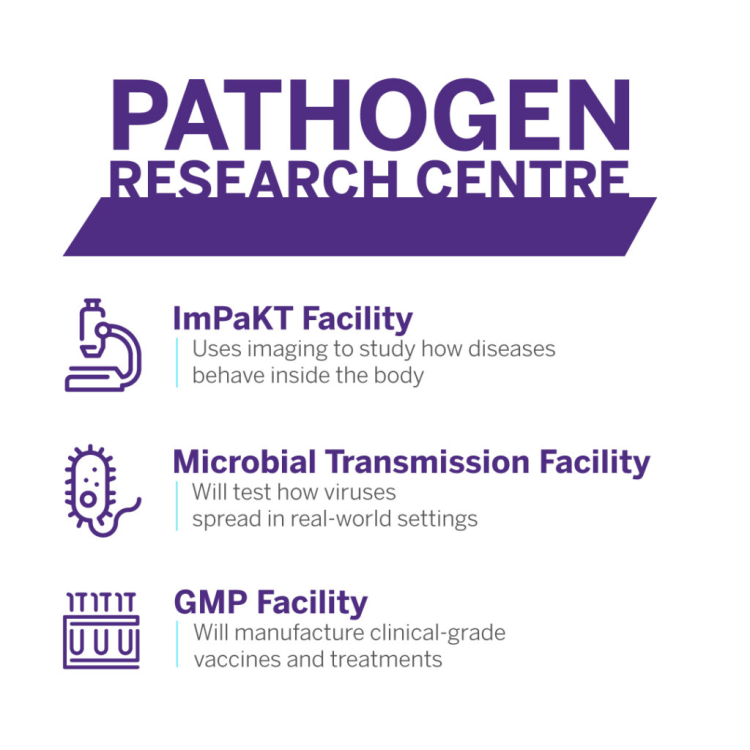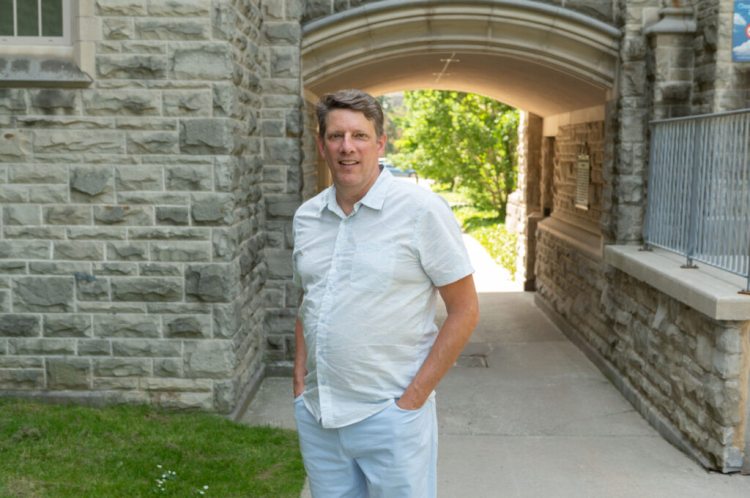Western has officially begun construction on a new research centre that will position London, Ont. as a national leader in the understanding, prevention and treatment of infectious diseases.
A first in Canada, and one of only a few in the world, the $44-million Pathogen Research Centre will bring real-world testing environments, advanced containment and manufacturing of therapeutics for clinical trials under one roof.
It is supported by the Canada Foundation for Innovation Biosciences Research Infrastructure Fund ($16 million) and the Ontario Research Fund ($3.9 million).
"By investing in world-class research infrastructure like Western's Pathogen Research Centre, we are strengthening Canada's position as a global leader in biomedical innovation. This facility will help ensure Canadian research can move from discovery to impact - turning breakthrough ideas into life-saving solutions, creating good jobs and improving our readiness for future public health challenges," said Mélanie Joly, federal Minister of Industry.
The Centre, part of Schulich School of Medicine & Dentistry and set to open in 2027 on the Western Research Parks site, will enhance understanding of how viruses and bacteria spread through the air and advance the manufacture of vaccines and potential treatments for a wide range of diseases.
"This new Centre will be a major enhancement for London's economy, creating jobs and attracting investment to our growing life sciences sector," said Peter Fragiskatos, Member of Parliament for London Centre. "Beyond our city, it will play a vital role in Canada's ability to develop and produce innovative, home-grown, health solutions."
The Pathogen Research Centre will be home to two new state-of-the-art, biocontainment level 3 facilities:
- A Good Manufacturing Practice (GMP) facility designed to manufacture products for clinical trials under strict quality control standards
- A microbial transmission facility, the first of its kind in the world, that will enable scientists to test how viruses like influenza, RSV and SARS-CoV-2 (the virus that causes COVID-19) spread through the air in real-life settings, such as airplane cabins or hospital rooms

These new facilities will operate alongside Western's existing ImPaKT (Imaging Pathogens for Knowledge Translation) Facility, which specializes in early-stage research by using advanced imaging techniques to observe how diseases behave inside the body.
"The Pathogen Research Centre is the next step in evolving Western's world-class research in immunology and biotherapeutics while training the next generation of experts," said Western President Alan Shepard. "The addition of these two new advanced facilities, together with ImPaKT, creates a one-of-a-kind research environment that fosters innovation and builds capacity for Canada to develop life-changing treatments and prevention."
GMP facility: Producing made-in-Canada therapeutics
The new GMP facility will allow scientists and pharmaceutical partners to develop, test and produce promising therapeutics and vaccines for human clinical trials, one of only about a dozen of such facilities in the country, and will enhance the city's capacity as a clinical trials hub for the province and the country.
Schulich Medicine & Dentistry professor Eric Arts said the GMP facility will increase Canada's pharmaceutical capacity and reduce the need to outsource therapeutic and vaccine production to the U.S. and other countries. By enabling cost-effective, specialized small-scale production of pharmaceuticals for clinical trials, it will help advance innovative early-stage ideas that may have stalled in the past because of lack of access to manufacturing capabilities at home.

Eric Arts, Schulich Medicine & Dentistry professor (Schulich Medicine & Dentistry)
"Having the capacity to produce made-in-Canada vaccines and biotherapeutics for clinical trials is a major advancement for both research and the life sciences industry. Right now, there are very few facilities in Canada that provide this service, coupled with the research expertise we can provide here," said Arts, Canada Research Chair in HIV Pathogenesis and Viral Control. "The ability to produce and test homegrown therapeutics in Canada will mean more research, development and commercialization in the biomedical industry."
Because the GMP production capabilities will be located within a biocontainment level 3 facility, it can safely produce biotherapeutics, drugs made from living organisms or biological sources including monoclonal antibodies, vaccines and cell-based therapies used to treat diseases like cancer, diabetes and autoimmune disorders.
The GMP facility will also support a "predictive" vaccine platform, developed by a Western-led team, to generate promising vaccine candidates that could target future viral strains infecting humans, including influenza and coronaviruses.
"Ontario is home to world-class biotech researchers that drive our economy with innovations and real-world solutions that improve and save lives," said Nolan Quinn, Ontario Minister of Colleges, Universities, Research Excellence and Security. "Our government is proud to support Western University's Pathogen Research Centre so Ontario can continue to be a leader in understanding diseases and bolstering the development and manufacturing of treatments for decades to come."
Microbial transmission facility: Testing virus transmission in real-world circumstances
The Pathogen Research Centre will also be home to a microbial transmission facility that can mimic real-world environments such as operating rooms and airplanes for research into how viruses spread. By simulating conditions such as airflow, temperature, humidity and even coughing and sneezing, scientists and industry partners can design and validate innovative solutions to stop their transmission.

Rick Gibson, director of operations for ImPaKT (Schulich Medicine & Dentistry)
"This will be the first facility in the world to simulate how viruses spread in real-world settings, filling a critical gap in our understanding of pathogen transmission," said Rick Gibson, director of operations for ImPaKT. "We're already working with industry partners who are developing innovative ways to stop the spread of viruses, and this facility will give them the ability to work with us to validate those ideas and bring them to market."
Engineering professor Chris DeGroot is currently working with a company that manufactures UV lamps designed to kill viruses. He said the team is eager to test this and other innovative technologies inside the microbial transmission facility's large-scale chamber.
"This is a game-changer for our research at Western. It opens the door to new kinds of collaborations essential for advancing technology, and for the health care sector as a whole. It will also give our graduate students hands-on experience with industry-level tools and projects," said DeGroot. "Simply put, it gives us access to research capabilities you can't find anywhere else."













